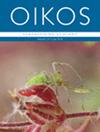Emergence of structure in plant–pollinator networks: low floral resource constrains network specialisation
IF 3
2区 环境科学与生态学
Q2 ECOLOGY
引用次数: 0
Abstract
Specialisation enhances the efficiency of plant–pollinator networks through the exchange of conspecific pollen transfer for floral resources. Floral resources form the currency of plant–pollinator interactions, but the understanding of how floral resources affect the structure of plant–pollinator networks remains modest. Previous theory predicts that optimally foraging animal species will specialise to improve resource acquisition under high resource availability. Although floral resource availability depends on both the plant production and animal consumption of the resources, previous work has assumed that production and availability are equivalent. This potentially may have led to erroneous inferences on the effect of resource availability on specialisation. We develop a mutualistic Lotka–Volterra consumer‐resource model to investigate the influence of floral resource availability on plant–pollinator network structure. The model incorporates animal adaptive foraging behaviour, floral resource dynamics, and density‐dependent dynamics. Specialisation, nestedness and modularity of simulated networks generated from the model under a wide range of parameters were explained using the generalised linear model. We found that the distinction between floral resource dynamics and plant density dynamics was necessary for partial specialisation of plant–pollinator networks. This is because floral resource dynamics constrained animal preference due to its depletion by animal species. Floral resource abundance had a positive effect on network specialisation, but animal density had a negative effect on network specialisation. Floral resource dynamics thus play key roles in the structure of plant–pollinator networks, distinctive from plant species density dynamics.植物授粉者网络结构的形成:低花资源限制了网络的专业化
通过同种花粉转移换取花资源,专业化提高了植物授粉者网络的效率。花资源是植物-传粉昆虫相互作用的货币,但人们对花资源如何影响植物-传粉昆虫网络结构的了解仍然有限。以往的理论预测,在资源可用性高的情况下,最佳觅食动物物种将专门化以改善资源获取。虽然花卉资源的可用性取决于植物的产量和动物对资源的消耗量,但以往的研究假设产量和可用性是等同的。这有可能导致错误地推断资源可用性对特化的影响。我们建立了一个互惠的 Lotka-Volterra 消费者-资源模型,以研究花卉资源可用性对植物-传粉昆虫网络结构的影响。该模型结合了动物适应性觅食行为、花卉资源动态和密度依赖动态。利用广义线性模型解释了该模型在多种参数条件下生成的模拟网络的专业化、嵌套性和模块性。我们发现,区分花卉资源动态和植物密度动态对于植物-传粉昆虫网络的部分专业化是必要的。这是因为花卉资源的动态变化限制了动物的偏好,因为动物物种会消耗掉花卉资源。花卉资源丰度对网络专业化有积极影响,但动物密度对网络专业化有消极影响。因此,花卉资源动态在植物-传粉者网络结构中起着关键作用,与植物物种密度动态截然不同。
本文章由计算机程序翻译,如有差异,请以英文原文为准。
求助全文
约1分钟内获得全文
求助全文
来源期刊

Oikos
环境科学-生态学
CiteScore
6.20
自引率
5.90%
发文量
152
审稿时长
6-12 weeks
期刊介绍:
Oikos publishes original and innovative research on all aspects of ecology, defined as organism-environment interactions at various spatiotemporal scales, so including macroecology and evolutionary ecology. Emphasis is on theoretical and empirical work aimed at generalization and synthesis across taxa, systems and ecological disciplines. Papers can contribute to new developments in ecology by reporting novel theory or critical empirical results, and "synthesis" can include developing new theory, tests of general hypotheses, or bringing together established or emerging areas of ecology. Confirming or extending the established literature, by for example showing results that are novel for a new taxon, or purely applied research, is given low priority.
 求助内容:
求助内容: 应助结果提醒方式:
应助结果提醒方式:


